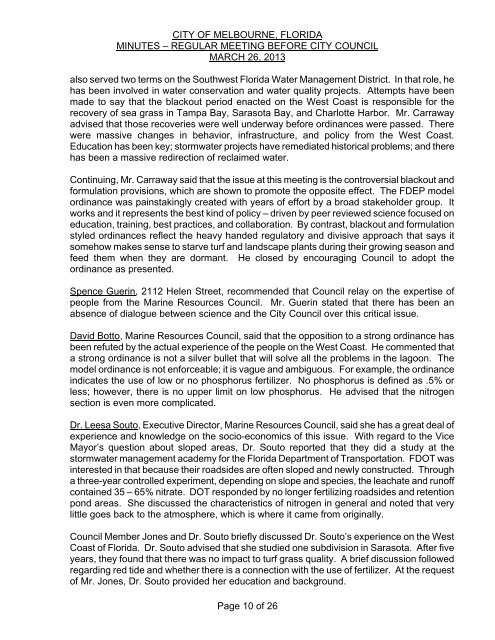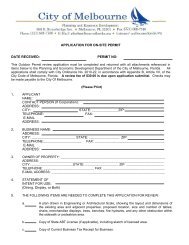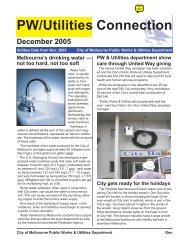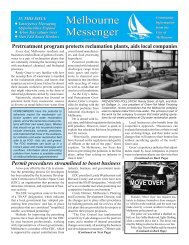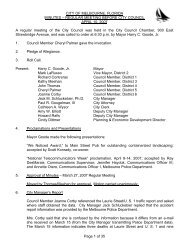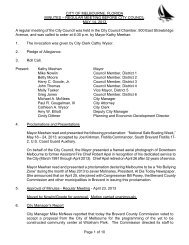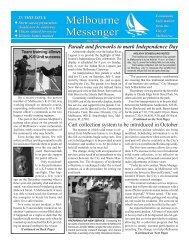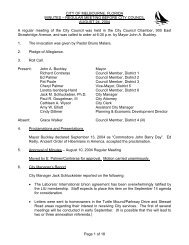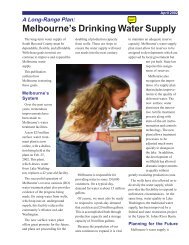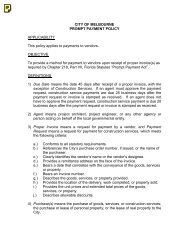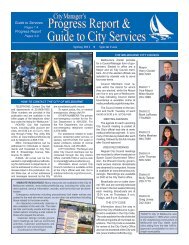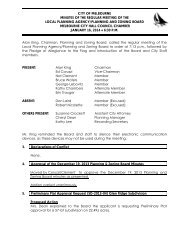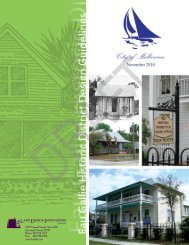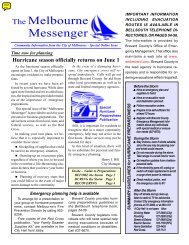March 26 - City of Melbourne, Florida
March 26 - City of Melbourne, Florida
March 26 - City of Melbourne, Florida
You also want an ePaper? Increase the reach of your titles
YUMPU automatically turns print PDFs into web optimized ePapers that Google loves.
CITY OF MELBOURNE, FLORIDA<br />
MINUTES – REGULAR MEETING BEFORE CITY COUNCIL<br />
MARCH <strong>26</strong>, 2013<br />
also served two terms on the Southwest <strong>Florida</strong> Water Management District. In that role, he<br />
has been involved in water conservation and water quality projects. Attempts have been<br />
made to say that the blackout period enacted on the West Coast is responsible for the<br />
recovery <strong>of</strong> sea grass in Tampa Bay, Sarasota Bay, and Charlotte Harbor. Mr. Carraway<br />
advised that those recoveries were well underway before ordinances were passed. There<br />
were massive changes in behavior, infrastructure, and policy from the West Coast.<br />
Education has been key; stormwater projects have remediated historical problems; and there<br />
has been a massive redirection <strong>of</strong> reclaimed water.<br />
Continuing, Mr. Carraway said that the issue at this meeting is the controversial blackout and<br />
formulation provisions, which are shown to promote the opposite effect. The FDEP model<br />
ordinance was painstakingly created with years <strong>of</strong> effort by a broad stakeholder group. It<br />
works and it represents the best kind <strong>of</strong> policy – driven by peer reviewed science focused on<br />
education, training, best practices, and collaboration. By contrast, blackout and formulation<br />
styled ordinances reflect the heavy handed regulatory and divisive approach that says it<br />
somehow makes sense to starve turf and landscape plants during their growing season and<br />
feed them when they are dormant. He closed by encouraging Council to adopt the<br />
ordinance as presented.<br />
Spence Guerin, 2112 Helen Street, recommended that Council relay on the expertise <strong>of</strong><br />
people from the Marine Resources Council. Mr. Guerin stated that there has been an<br />
absence <strong>of</strong> dialogue between science and the <strong>City</strong> Council over this critical issue.<br />
David Botto, Marine Resources Council, said that the opposition to a strong ordinance has<br />
been refuted by the actual experience <strong>of</strong> the people on the West Coast. He commented that<br />
a strong ordinance is not a silver bullet that will solve all the problems in the lagoon. The<br />
model ordinance is not enforceable; it is vague and ambiguous. For example, the ordinance<br />
indicates the use <strong>of</strong> low or no phosphorus fertilizer. No phosphorus is defined as .5% or<br />
less; however, there is no upper limit on low phosphorus. He advised that the nitrogen<br />
section is even more complicated.<br />
Dr. Leesa Souto, Executive Director, Marine Resources Council, said she has a great deal <strong>of</strong><br />
experience and knowledge on the socio-economics <strong>of</strong> this issue. With regard to the Vice<br />
Mayor’s question about sloped areas, Dr. Souto reported that they did a study at the<br />
stormwater management academy for the <strong>Florida</strong> Department <strong>of</strong> Transportation. FDOT was<br />
interested in that because their roadsides are <strong>of</strong>ten sloped and newly constructed. Through<br />
a three-year controlled experiment, depending on slope and species, the leachate and run<strong>of</strong>f<br />
contained 35 – 65% nitrate. DOT responded by no longer fertilizing roadsides and retention<br />
pond areas. She discussed the characteristics <strong>of</strong> nitrogen in general and noted that very<br />
little goes back to the atmosphere, which is where it came from originally.<br />
Council Member Jones and Dr. Souto briefly discussed Dr. Souto’s experience on the West<br />
Coast <strong>of</strong> <strong>Florida</strong>. Dr. Souto advised that she studied one subdivision in Sarasota. After five<br />
years, they found that there was no impact to turf grass quality. A brief discussion followed<br />
regarding red tide and whether there is a connection with the use <strong>of</strong> fertilizer. At the request<br />
<strong>of</strong> Mr. Jones, Dr. Souto provided her education and background.<br />
Page 10 <strong>of</strong> <strong>26</strong>


